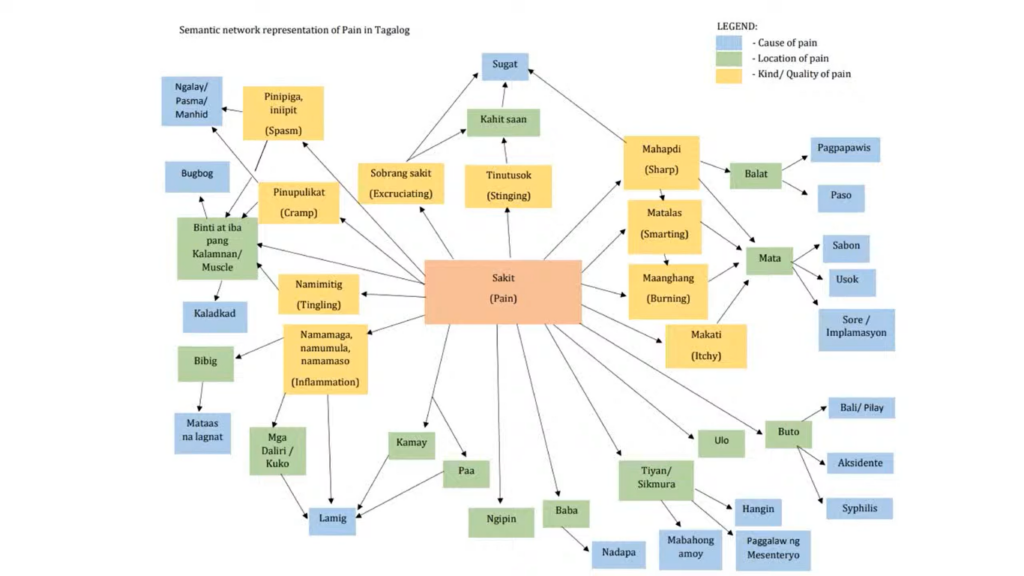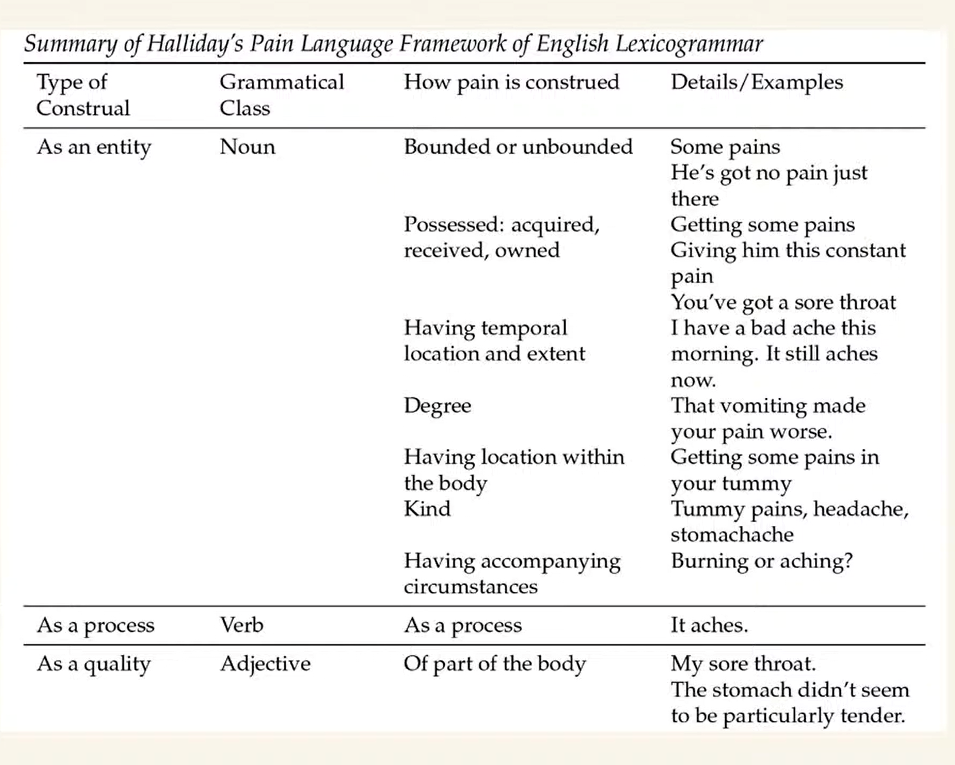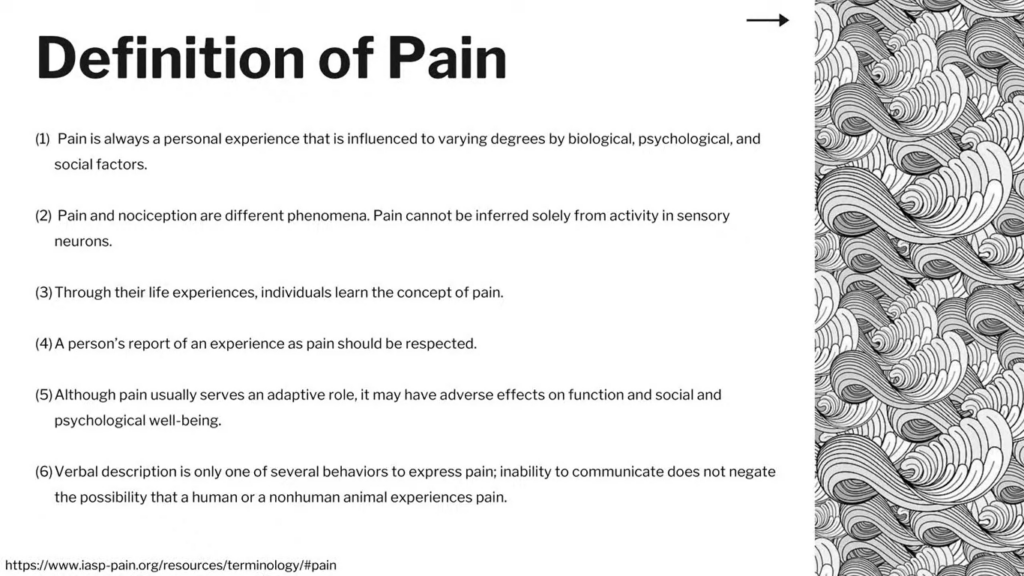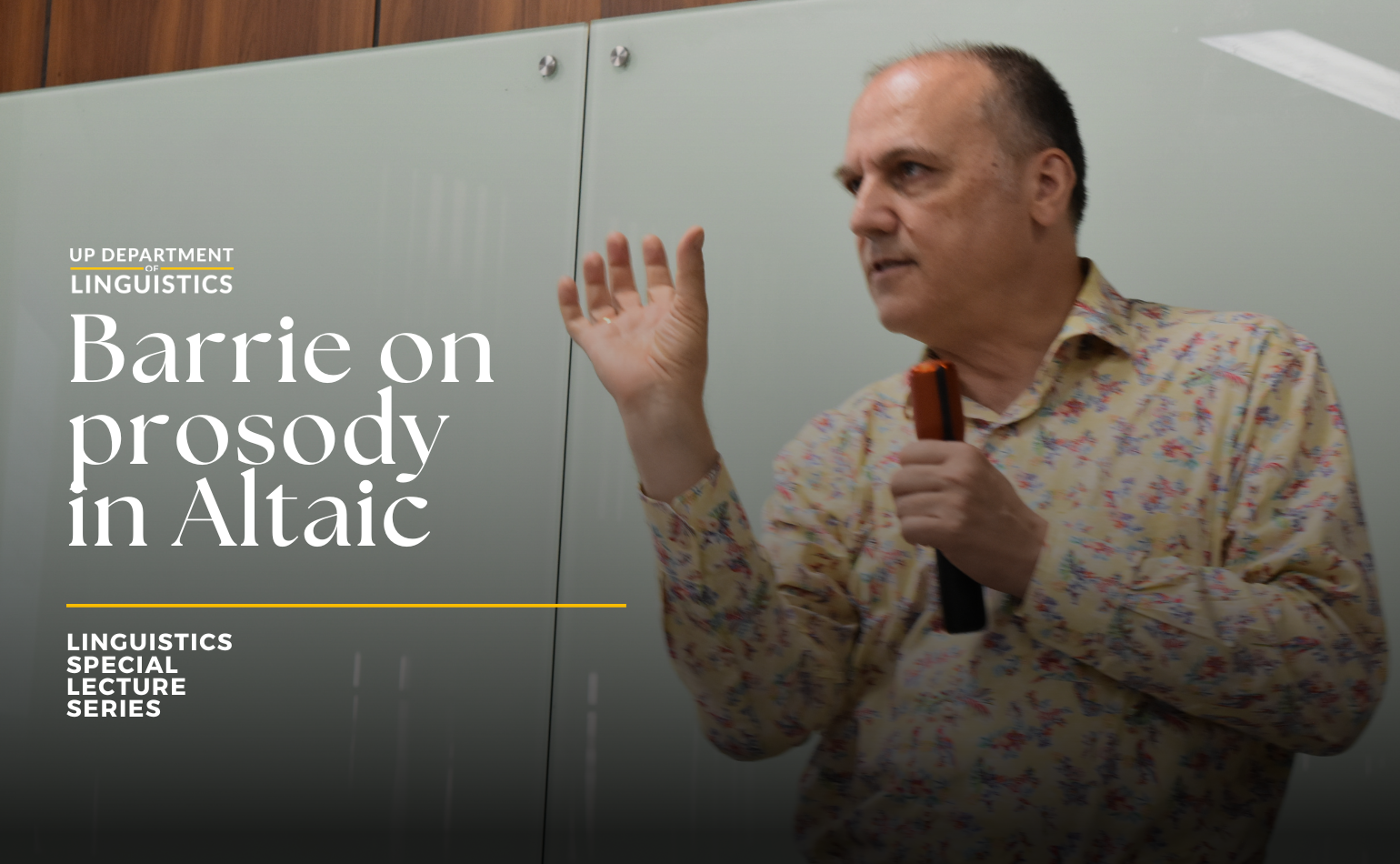
The second installment of Lexicon Unpacked focused on the term sakít (‘pain’) and featured the studies conducted by BA Linguistics (2022) alum Mary Dianne Jamindang and Michael Manahan. The webinar was held last November 15, and the recording of this lecture is available on the Department’s YouTube channel.
Pain is considered a universal human phenomenon, but is also an exclusive and subjective experience that a sufferer undergoes (Sussex, 2009). Ms. Jamindang’s presentation, titled “Sakit: A Preliminary Linguistic Analysis on Tagalog Pain Language and Concept,” generated insights on why it is important to linguistically study pain. In paraphrasing an idea of Wierzbicka (2012), Jamindang emphasized that “the experience of ‘it hurts’ may be universal, but the concept of pain is not” since it is subject to linguistic constraints and cultural influences. She also mentioned that a deeper understanding of this concept “helps facilitate healthcare communication, proper management, and possibly treatment.”
She briefly explained her study’s methodology and the kind of analysis that she used. Forty-one (41) physical pain terms were acquired after conducting a dictionary sweep, and these were semantically categorized based on location, quality, and cause. She then created a representation of the semantic network of these lexical items to show how they relate to each other. Supporting data were also elicited through casual conversations with language consultants.

The map illustrates the fact that ideas surrounding the central concept have meaningful relationships with each other, and are essential to forming our knowledge of sakít. And apart from performing a semantic network analysis (Jonassen & Reeves, 1996; Nettleton, 2014), the study also employed Halliday’s (1998) grammar of pain framework, which states that experiences such as pain are construed in language as process, quality, or thing, which are related to the grammatical category the pain terms belong to, namely, nouns, verbs, and adjectives.

Two significant findings were formulated in this study: First, according to Jamindang, “sakít is a complex concept within a variety of experiences,” and second, it is “caused by conditions external and internal to the body.” The first point explored the different qualities of sensation (e.g. sharp, stinging, excruciating, tingling, burning, etc.) and observed that these vary according to location and cause of pain. The second point identified external (e.g. accidents, everyday objects, illnesses) and internal (e.g. kabag ‘gas pain,’ hima ‘pain in the skin due to sweat’ (Panganiban, 1972) causes of pain.
Examining the language of sakít, Jamindang found that pain is construed in Tagalog primarily as a process (e.g. “Sumasakit ang tiyan ko”), and secondarily as a quality (e.g. “Masakit ang tiyan ko”) and an entity (e.g. “Ang sakit sa tiyan ko ay hindi ko mawari”). It must be noted that languages interpret pain differently (Halliday, 1998; Lascaratou & Hatzidaki, 2002; Patharakorn, 2010), and thus pain is considered language and culture-specific.
In treating pain as a process in Tagalog, the voice of the verb reveals the degree of involvement (whether active or passive) of the sufferer. Pain is also usually located within the self, as in “Humihilab ‘yung tiyan mo” where pain is restricted in a single location, and “Binabalis na naman ako” where it is felt by the stomach and the entire self.
Looking at pain as a quality, it was observed that only the terms sakit (as in “Masakit ang pilay”), kirot (as in “Namumula na makirot ang paningin ko”), and hapdi (as in “Mahapdi ang sugat ko”) can take the adjectival construction. Painful attributes are possessed by body parts and the whole experience realized by the pronoun siya ‘it’, but not by the whole self (as in “#Mahapdi ako” or “#Makirot ka”). Meanwhile, pain as an entity can be one of the following: an undesired possession, a noun modifier modifying the subject, the actor that causes the pain, or the subject of the sentence.
Finally, Jamindang suggested that further research should be done regarding the metaphors for sakít, and shared an observation that, based on how it is construed in Tagalog, pain is conceptualized in Tagalog culture “as an actor or some invisible force that violates the body.”
This presentation is part of Ms. Jamindang’s undergraduate research paper published in the first volume of the 2022 UP Working Papers in Linguistics (UPWPL). You can read her work here.
Manahan analyzed sakít using the Natural Semantic Metalanguage (NSM) framework. He began his talk by reporting how the Philippines consistently ranks high in the Gallup Emotions Report. Manahan says that this is an indicator of the Filipinos’ acknowledgment of their emotions and their willingness to express these. Among those factored in the survey is physical pain. He also considered the International Association for the Study of Pain’s (IASP) definition of the term, and specifically identified points 1, 3, and 6 as the guides in this ethnolinguistic study.

Manahan explained that the wide-ranging domain of emotion is well-explored in NSM because the concepts that fall under it produce productive representations of similarities, differences, and relationships of terms. NSM is a tool for linguistic and cultural analysis that uses reductive paraphrases known as semantic primes which give form and definition (or explication) to a concept (NSM-Approach.net).
In this analysis, the definition of sakit from diksiyonaryo.ph was divided into two segments: “Hindi kanais-nais na pakiramdam bunga ng pagkasira ng metabolismo ng katawan” and “Hindi kanais-nais na pakiramdam bunga ng… sakuna, o mga katulad.” Separate explications for the two parts were constructed, the first one focusing on “bodily bad feelings,” and the second on “emotional pain.” Sample sentences elicited from online sources supported the explications that physical pain refers to the idea that “this someone feels something bad in this part of the body because of this,” while emotional pain suggests that “this someone feels something bad because of this.”
Related terms like hapdi ‘smarting pain; stinging pain; sharp pain’ and kirot ‘sharp or stinging pain’ (English, 1986) were also examined. Constructed explications for hapdi and kirot in terms of physical pain reveal differences in the origin or source of pain, the former being experienced on a particular side or on the surface, and the latter being felt internally. In terms of emotional pain, hapdi and kirot can function as substitutes for sakit.
Manahan ended by mentioning further explorations that can be done for this topic. Some of these are the investigation of the expression of intensity and duration of pain, the unpacking of other relevant pain terms, and the analysis of pain metaphors. His study is a contribution to the understanding of pain and its relevance to our daily lives, as well as to the underscoring of the importance of emotional semantics.
Some questions raised during the open forum were inquiries regarding pain terms that are unique to Tagalog, archaic and new lexical items, the probable positive connotation of pain, the relevance of localizing Western medical terms, and the spiritual dimension of pain.
The theme for this installment of the Department’s Lexicon Unpacked was also chosen in honor of Dr. Consuelo Paz, who was one of the pioneers in the study of the relationship between language and culture in the Philippines. You can alswatch the previous installment of Lexicon Unpacked on the Department’s YouTube channel.
Published by Patricia Anne Asuncion



